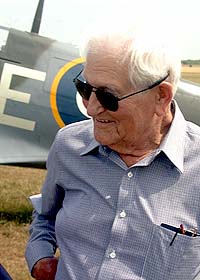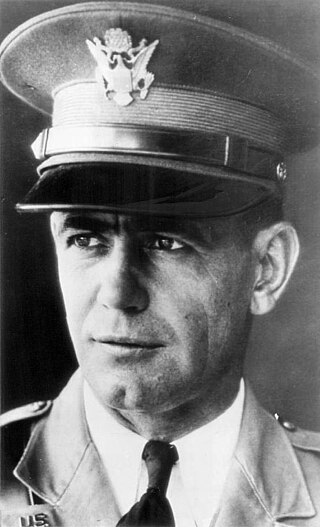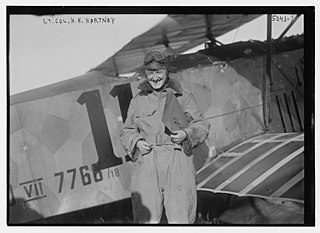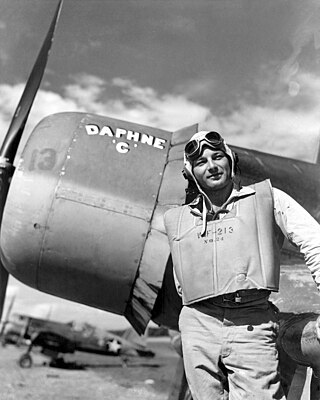
The Royal Flying Corps (RFC) was the air arm of the British Army before and during the First World War until it merged with the Royal Naval Air Service on 1 April 1918 to form the Royal Air Force. During the early part of the war, the RFC supported the British Army by artillery co-operation and photographic reconnaissance. This work gradually led RFC pilots into aerial battles with German pilots and later in the war included the strafing of enemy infantry and emplacements, the bombing of German military airfields and later the strategic bombing of German industrial and transport facilities.

The Distinguished Flying Cross (DFC) is a military decoration of the United States Armed Forces. The medal was established on July 2, 1926, and is currently awarded to any persons who, after April 6, 1917, distinguish themselves by single acts of heroism or extraordinary achievement while participating in aerial flight. Both heroism and extraordinary achievement are entirely distinctive, involving operations that are not routine. The medal may be awarded to friendly foreign military members in ranks equivalent to U.S. Pay Grade of O-6 and below, in actual combat in support operations.

A flying ace, fighter ace or air ace is a military aviator credited with shooting down five or more enemy aircraft during aerial combat. The exact number of aerial victories required to officially qualify as an ace is varied, but is usually considered to be five or more.
This is a list of aviation-related events from 1918:

General John Charles Meyer was an American World War II flying ace, and later the commander-in-chief of the Strategic Air Command (SAC) and director of the Joint Strategic Target Planning Staff at Offutt Air Force Base, Nebraska. SAC was the United States' major nuclear deterrent force with bombers, tankers and reconnaissance aircraft, and intercontinental ballistic missiles. The Joint Strategic Target Planning Staff coordinated the nation's nuclear war plans and developed the Single Integrated Operations Plan.

Oliver Colin LeBoutillier was an American aviator and flying ace. Serving with the British Royal Naval Air Service and Royal Air Force in the First World War, LeBoutillier scored 10 aerial victories, witnessed the death of Manfred von Richthofen and was a vigorous proponent of Captain Roy Brown as the victor over Richthofen. Post war, he became a stunt pilot for movies, a skywriter, and an aviation instructor whose most famous student was Amelia Earhart. Later, he became a civil aviation inspector.

Colonel Walker Melville "Bud" Mahurin was a United States Air Force officer and aviator. During World War II, while serving in the United States Army Air Forces, he was a flying ace.

Major David McKelvey Peterson was a 1915 Lehigh University graduate who became a World War I flying ace. He achieved six aerial victories, one of which was earned in the Lafayette Escadrille; five were officially credited during his tenure with the United States Army Air Service.

Donald James Matthew Blakeslee was an officer in the United States Air Force, whose aviation career began as a pilot in the Royal Canadian Air Force flying Spitfire fighter aircraft during World War II. He then became a member of the Royal Air Force Eagle Squadrons, before transferring to the United States Army Air Forces in 1942. He flew more combat missions against the Luftwaffe than any other American fighter pilot, and by the end of the war was a flying ace credited with 15.5 aerial victories.

John Franklin Bolt was a naval aviator in the United States Marine Corps and a decorated flying ace who served during World War II and the Korean War. He remains the only U.S. Marine to achieve ace status in two wars and was also the only Marine jet fighter ace. He rose to the rank of lieutenant colonel during his military career.

Harold Huston George was a general officer in the United States Army Air Forces during World War II. He began his military career before World War I when he enlisted as a private in the 3rd New York Infantry Regiment. Joining the Air Service, he became an ace in France in 1918, credited with five aerial victories.

Lieutenant William Dolley Tipton began his military career as a World War I Sopwith Camel pilot. The U.S. Air Force officially credits him with four aerial victories during the war, although other sources claim he had five, and thus was a flying ace. He was one of the founding officers of what would become the Maryland Air National Guard. As a member of the Maryland National Guard, he was mobilized during World War II. He rose to the rank of colonel during the war. He died on December 12, 1945, in an aircraft accident. Tipton Airport in Anne Arundel County, Maryland, is named in his honor.

Harold Evans Hartney was a Canadian-born World War I flying ace who served in the Royal Flying Corps and then in the United States Army Air Service, credited with seven confirmed and one unconfirmed aerial victories.

Captain Gorman DeFreest Larner was a World War I flying ace credited with seven aerial victories.

Major James Armand Meissner was a World War I flying ace credited with eight aerial victories and awarded two Distinguished Service Crosses.
Lieutenant Eugene Seeley Coler (1896-1953) was an American World War I flying ace who served in the British Royal Flying Corps and Royal Air Force. He was credited with 16 aerial victories.

During World War I, the national air services involved developed their own methods of assessing and assigning credit for aerial victories.

James Norman Cupp was a United States Marine Corps aviator during World War II. Cupp was a double flying ace with at least 12 aerial victories in the Solomon Islands during three months of World War II. He was a recipient of the Navy Cross, the navy's second highest military decoration for valor and was a four time recipient of the Distinguished Flying Cross. Also a Korean War veteran, he retired as a colonel to Manassas, Virginia, in 1968.

Gerald Richard Johnson was a World War II flying ace who flew for the United States Army Air Forces. Johnson commanded the 9th Fighter Squadron and 49th Fighter Group, and became the fourth ranking fighter ace in the Pacific during World War II. He ended his war career with 22 kills.

Archie Glenn Donahue was a decorated American combat pilot and a United States Marine Corps fighter ace during World War II. He shot down a total of 14 Japanese planes during the war, including five in a single day.

















